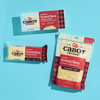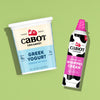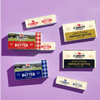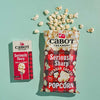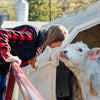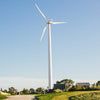
University Dairy Farms Shaping the Future of Dairy
Hundreds of family farms across New England and New York make up Cabot Creamery Cooperative — each one playing a vital role in bringing high-quality dairy products to tables near and far. Our farmer-owned cooperative dates back to 1919, when 94 farmers came together to ensure their livelihood and the future of dairy. The farmers built the cooperative on a simple but powerful idea: we’re stronger together than we are apart.
They were onto something. Today, Cabot is made up of thousands of people across four creameries in three states, and hundreds of farmer owners throughout New England. Among the farmer owners are university farms like the University of Vermont, the University of Maine, and the University of Connecticut, where college dairy programs give students hands-on learning experiences while also operating as working dairy farms.
The university farms are more than milk producers — they’re classrooms, research centers, and incubators for the next generation of agricultural leaders. Their work reflects the very heart of Cabot’s cooperative spirit: innovation, education, and care for the community.
By pairing hands-on learning with cutting-edge research, these programs help shape a sustainable future for dairy farming. Just like the early co-op members, the work of the university dairy farms ensures that both the land and the livelihoods it supports continue to thrive long into the future.
Education, Innovation, and Community
University farms are proud members of the Cabot Cooperative, producing high-quality milk for our award-winning products, while also serving as living classrooms and research centers for students. Being a part of the cooperative gives the universities access to the same resources as other Cabot farms, while also providing unique opportunities for research and innovation.
The dairy programs focus on areas like cow health and comfort, herd management, soil conservation, and crop management, allowing students and faculty to explore real-world solutions that benefit both the farm and the broader dairy community.
"The future of farming depends on programs like these," says Cabot's Erika Anderson-Putman, Cabot's Community Marketing Associate. "They ensure that dairy farming and dairy products continue to enrich our communities, landscapes, and meal tables for generations to come."
Many graduates of the university programs go on to careers in agriculture, including working on farms and in animal health, carrying the skills and lessons learned in the dairy program into the farms and communities they serve. This connection reflects shared values, mutual growth, and proof that when farmers, students, and educators work together, everyone benefits.
"There are seven cooperative principles, and 'Education and' 'Care for Community' are two of them,” explains Anderson-Putman. “As a farmer-owned cooperative, finding a home for members' milk, making high-quality products, and enriching our local communities is important to us. Having these university farms connected to the co-op ensures a future for farming,” she continues.
Let's meet some of these university dairy programs and see how they're bringing learning, research, and the next generation of dairy leaders to life.
University of Vermont
Not many students can say they have a working dairy farm less than a mile from their college dorm, and even fewer get to learn there as part of a real cooperative. But at the University of Vermont, the CREAM program — short for Cooperative for Real Education in Agriculture Management — gives students the chance to work directly with a professional dairy herd, earn academic credit, and help contribute high-quality milk that goes into Cabot’s award-winning products.

Each year, roughly 25 students are accepted into the two-semester program, making it highly competitive, with more than 65 applicants vying for a spot this cycle alone. The program is open to students of any major but is dominated by animal science majors, most with pre-veterinary concentrations. And, just like life on a dairy farm, the work is demanding.The course structure is rigorous: each week, students attend two classes, two farm meetings, and complete 3-4 farm chores. But the hard work and real-life experience working on the farm alongside herd managers Faerin Dick and Matt Bodette, and learning from faculty advisor Dr. Stephen Wadsworth, is more than the students could ask for.
“CREAM is an incredible opportunity to learn about agriculture, dairy management, cow handling, teamwork, grit, and so much more,” says Anna Fennell, UVM ‘26. “This program teaches students beyond the classroom, providing hands-on experience that is practically impossible to find elsewhere!”

Dr. Wadsworth is a seasoned cattle veterinarian who brings decades of hands-on experience in the dairy industry to the classroom. His expertise in animal health provides students with a wealth of knowledge, but he also focuses his teaching on personal growth and good character. From day one, students are encouraged to cultivate gratitude for the people, the planet, and the animals that make the farm possible, which leaves a lasting impression on everyone in the program. “CREAM is a life-changing opportunity that provides unconditional kindness, knowledge, and generosity to both the cows and students involved,” Fennell adds.
The program’s herd consists of about 100 registered Holsteins, with 56 being milked at any given time. Students work closely with herd managers and Dr. Wadsworth, learning to manage herd health, milk production, and welfare. The weekly farm chores are central to experiential learning, and with most of the Holsteins producing more than 100 pounds of milk daily, there is no shortage of opportunities to contribute!

Students learn to handle and milk the herd — some of which weigh up to 2,000 pounds — a couple of times a day to maintain clean, high-quality milk with consistently low somatic cell counts. The herd’s size and productivity are linked to its carefully calculated breeding decisions, which contribute to the herd being ranked fourth in the country for genetic excellence out of all university-owned herds.
Beyond their daily chores, CREAM students serve on specialized committees focused on different aspects of herd management, including vaccinations, cow cleanliness, and calf care. These committees give students the chance to develop leadership skills, take ownership of specific areas, and collaborate closely with peers, helping them prepare for real-world decision-making in agriculture, veterinary medicine, or animal science.

The program also continues to invest in herd welfare and innovation. In 2025, the farm upgraded to new milking units with advanced suction technology to improve cow comfort and efficiency. And, speaking of comfort, the cows now have brand-new memory-foam mattresses in the barn. But they’re not just comfortable — they’re high-tech, too. A company called Smaxtec recently donated boluses to help collect data from the herd. The boluses function like a cow "Fitbit" to track temperature, rumination, water intake, and activity levels, which allows the team to monitor herd health proactively.
Working closely with the herd, students see how their daily efforts matter in the larger world of dairy. Since joining the Cabot Cooperative in 1988, CREAM has given them hands-on experience with the cooperative model, showing how milk from their cows becomes part of award-winning Cabot products. For many students, this connection to real-world farming and community-owned agriculture helps them understand the bigger picture behind the work they do every day. The program also prepares graduates for careers in veterinary medicine, agriculture, and animal science, with many choosing UVM specifically to take part in this one-of-a-kind learning opportunity.
“CREAM isn’t just about milking cows and making money — it’s about growth,” says Ella Gingras, UVM ’27. “Through early mornings and tough decisions, you learn so much about yourself as you do dairy. Thriving in the program demands grit and responsibility, but above all, it teaches kindness.”
University of Maine
At the University of Maine’s J.F. Witter Teaching and Research Center, learning is more than a living classroom — it's central to the university’s land-grant mission to provide education, conduct research, and extend knowledge to Maine’s citizens and beyond. The dairy program has been part of the cooperative network that became Cabot since the early 1900s, back when the original dairy farm was established with the land-grant university. In the more than 100 years since, it has connected students with farmers and researchers across New England while supporting Maine’s dairy industry.

Students in the Animal and Veterinary Science program take at least three courses at the Witter Center, gaining invaluable hands-on experience working with dairy cattle. As part of the program, students assist with farm chores like feeding calves, monitoring cow health, and cleaning pens. Those in the dairy program are also assigned to pregnant cows and are present during calving to help care for the animals, including vaccinations, dipping navels, and collecting colostrum. And most importantly? Naming their calf.

“We really focus on teaching students the meaning of hard work on a dairy farm and the importance of being vigilant and working with the cows to identify and communicate any problems,” explains Patricia Henderson, Farm Superintendent at the Witter Center. “These skills are valuable for careers in veterinary science and the agricultural industry, helping students notice and communicate things about animals that might be overlooked in the classroom.”
Students find the calving experience incredibly rewarding. “It’s a lot of fun, and the students really look forward to being in the barn with the cows,” Henderson adds.
In 2024, the university unveiled a state-of-the-art robotic milking facility, a project three years in the making. The barn — designed to mimic what a traditional small family farm in Maine could do — can house up to 50 lactating cattle. Currently, the dairy farm is milking 35 registered Holstein cows, milked 24 hours a day by a DeLaval VMS 300 robotic system. “We needed to upgrade from our outdated tie-stall barn, and we knew investing in technology would benefit our students, research, and the state’s dairy industry as a whole,” says Henderson. “It’s the best thing we’ve ever done for the cows.”

Research at the Witter Center — which is part of the Maine Agriculture and Forestry Experiment Station (MAFES) — spans reproductive biology, foraging efficiency, and sustainable innovation. The team is currently pursuing grants to add innovative technology to the robotic milking system that can detect pregnancy sooner from milk samples. They are also working on a long-term grant to introduce solar grazing to fields to more effectively pasture heifers and dry cows while producing electricity. Together, this research and these initiatives demonstrate how university programs like Witter are driving innovation and shaping the future of the industry.
Beyond the barn, UMaine participates in Discover Dairy’s “Adopt-a-Cow” program, which connects elementary and middle school classrooms across Maine to life on a working dairy farm. Each month, students receive updates about their adopted calf and, at the end of the year, visit the Witter Center to meet their calf in person. This free program helps educate young students about dairy farming and the work that goes into producing milk — sparking curiosity and a love for agriculture that, who knows, might inspire some to explore farming later in life.
With more than 2,000 visitors each year, UMaine’s Witter Center continues to grow as a destination for education, innovation, and inspiration. Its partnership with Cabot reinforces the cooperative spirit, connecting students and faculty to a broader network of farmers while highlighting sustainability and community across New England.
“Being part of the co-op helps show our students that we’re more than just a tiny farm in Central Maine — it ties the whole industry together,” says Henderson.
University of Connecticut
At the University of Connecticut, the Kellogg Dairy Center gives students hands-on experience managing a herd of 60 registered Holsteins and 30 registered Jerseys. Students work closely with the herd using two Delaval Classic VMS robotic systems, which allows students to learn modern dairy technology in action. And beyond milking, the Delaval Behavior Analysis system gives visibility to eating and rumination times and increased activity when cows are in heat — all data that helps students understand how technology and animal care work together to keep cows healthy through early intervention.

Each year, around 150 incoming Animal Science majors join a program that blends classroom learning with hands-on experience. From introductory courses like Dairy Management and Nutrition to advanced electives in Genetics, Growth, and Metabolism, students build a strong academic foundation. But much of the learning happens in the barns, where students get hands-on experience caring for the herd — feeding, grooming, monitoring health, and learning daily management practices. One highlight is the opportunity to select a heifer and work with it for six weeks, preparing to show it at the UConn Dairy Show. Through these experiences, students build confidence, practical skills, and a deep respect for the animals in their care.
The program’s excellence and commitment to herd care has been recognized beyond the university level. In 2024, the Kellogg Dairy Center was awarded the prestigious Green Pastures award, which honors outstanding dairy farms for overall farm management, environmental stewardship, and contributions to their local and regional agricultural communities.

“We were honored to receive the 2024 Green Pastures award. As a land grant University, I feel we should be leading by example in all aspects of our agricultural endeavors,” says Mary Margaret Smith, Educational Program Manager. “We feel a tremendous obligation to be excellent stewards of our agricultural land and our animal herds.”
Hands-on learning is central to that mission. Students can even live on-site, exchanging work for housing as they work together on the night shift feeding calves, taking care of fresh cows, grooming stalls, training fresh heifers to use the robot, diagnosing sick animals, and administering treatment. Staff are on call for students to reach by phone if they have questions or need help with developing treatment plans or emergencies. These students are also able to assist with research projects — collecting samples, tracking data, and analyzing results.
Beyond the farm, the program is also big on community involvement. There is a division for 4-H and FFA, which helps encourage young people to consider UConn as their college of choice for dairy education. The UConn Dairy Club also brings 15 heifers to the Big E every year, where students spend four days answering questions and engaging with the public about the dairy industry. And you may even spot UConn’s cows popping up around campus — during exam week, dairy students bring them out so the general student population can pet a heifer to help relieve stress.
Students can also get a taste of the dairy program’s hard work at the UConn Dairy Bar. Opened in 1953, the dairy bar sells dairy products made by the UConn Creamery, still using its original ice cream recipe. Visitors can also find UConn eggs, artisanal cheese, and other frozen treats like ice cream sandwiches. The ice cream consistently wins awards and recognitions, including Yankee Magazine’s Best of New England Hall of Fame, The Chronicle’s Best of Reader’s Choice, and Best of Hartford.
“Students take pride knowing they play a part in ensuring only the highest-quality milk gets produced at the Kellogg Dairy Center, which goes down to the creamery where it’s used to make UConn ice cream and cheeses,” says Bonnie Burr, Department Head of Extension in the College of Agriculture, Health and Natural Resources. "And we love telling visitors that our milk also goes into Cabot’s award-winning products.”
Since joining the Cabot Cooperative in 1991, UConn’s dairy program has played an active role in the region’s broader agricultural community. “It’s a great way to teach students about the co-op model,” says the dairy team. “They see how their milk goes into both our UConn ice cream and Cabot products found in stores — and visitors love making that local connection.”
“While students may not fully understand all the logistics of the co-op model, they definitely understand quality,” the team adds. “They’re proud to know the milk they produce meets the high standards Cabot is known for.”
Shaping the Future of Dairy
University dairy programs are undoubtedly cultivating the leaders, innovators, and farmers of tomorrow. Through hands-on learning, advanced technology, and contributing to the cooperative, students gain the skills and experience necessary to shape the future of dairy. The students' dedication to the herd continues to drive our cooperative and the industry forward, and we can't wait to see where their future takes them—maybe even as a farmer-owner in our cooperative!



